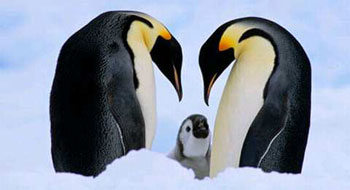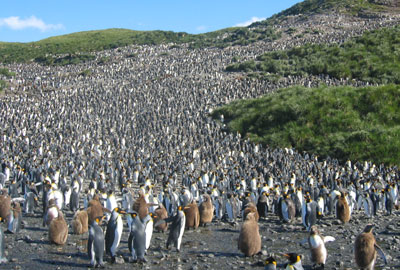|
|

Interesting Facts About Emperor
Penguins
 |
�
Scientific Name: Aptenodytes forsteri
Kingdom: Animalia
Phylum: Chordata
Class: Aves
Order: Ciconiiformes
Family: Spheniscidae
Genus: Aptenodytes
Species: Aptenodytes forsteri. |
Habitat
The Emperor Penguin has a circumpolar distribution in the Antarctic
almost exclusively between the 66� and 77� south latitudes. It almost
always breeds on stable pack ice near the coast and up to 18 km (11
mi) offshore. Breeding colonies are usually located in areas where
ice cliffs and icebergs shelter them from the wind. The total population
is estimated at around 400,000�450,000 individuals, which are distributed
among as many as 40 independent colonies. Around 80,000 pairs breed
in the Ross Sea sector. Major breeding colonies are located at Cape
Washington (20,000�25,000 pairs), Coulman Island in Victoria Land
(around 22,000 pairs), Halley Bay, Coats Land (14,300�31,400 pairs),
and Atka Bay in Queen Maud Land (16,000 pairs). Two land colonies
have been reported: one on a shingle spit at Dion Island on the Antarctic
Peninsula, and one on a headland at Taylor Glacier in the Australian
Antarctic Territory.
Adaptations to Cold
The Emperor Penguin breeds in the coldest environment of any bird
species; air temperatures may reach -40 �C (-40 �F), and wind speeds
may reach 144 km/h (89 mph). Water temperature is a frigid -1.8 �C
(28.8 �F),which is much lower than the Emperor Penguin's average body
temperature of 39 �C (102 �F). The species has adapted in several
ways to counteract heat loss. Feathers provide 80�90% of its insulation,
and it has a layer of sub-dermal fat which may be up to 3 cm (1.2
in) thick before breeding. This resultant blubber layer impedes the
mobility of the Emperor on land compared to its less well fat-insulated
cousin, the Magellanic Penguin. Its stiff feathers are short, spear-shaped,
and densely packed over the entire skin surface. With around 100 feathers
covering one square inch (15/cm2), it has the highest feather density
of any bird species. An extra layer of insulation is formed by separate
shafts of downy filaments between feathers and skin. Muscles allow
the feathers to be held erect on land, reducing heat loss by trapping
a layer of air next to the skin. Conversely, the plumage is flattened
in water, thus waterproofing the skin and the downy underlayer.
Preening is vital in facilitating insulation and in
keeping the plumage oily and water-repellent. The Emperor Penguin
is able to maintain its core body temperature without altering its
metabolism, over a wide range of temperatures. Known as the thermoneutral
range, this extends from -10 to 20 �C (10 to 70 �F). Below this temperature
range, its metabolic rate increases significantly, although an individual
can maintain its core temperature between 37.6 and 38.0 �C (99.7 to
100.4 �F) down to -47 �C (-53 �F). Movement by swimming, walking,
and shivering are three mechanisms for increasing metabolism. At temperatures
above 20 �C (68 �F), an Emperor Penguin may become agitated as its
body temperature and metabolic rate rise to increase heat loss. Raising
its wings and exposing the undersides increases the exposure of its
body surface to the air by 16%, facilitating further heat loss.
Diet
The Emperor Penguin's diet consists mainly of fish, crustaceans
and cephalopods, although its composition varies from population
to population. Fish are usually the most important food source,
and the Antarctic silverfish makes up the bulk of the bird's diet.
Other prey commonly include squid and Antarctic krill. The Emperor
Penguin forages in the open water of the Southern Ocean, in either
ice-free areas of open water or tidal cracks in pack ice. One
of its feeding strategies is to dive to around 50 m (164 ft),
where it can easily spot sub-ice fish swimming against the bottom
surface of the sea-ice; it swims up to the bottom of the ice and
catches the fish. It then dives again and repeats the sequence
about half a dozen times before surfacing to breathe. Emperor
Penguins dive for up to 22 minutes to depths of up to 1500 feet. |
|
Predators
The Emperor Penguin's predators include birds and aquatic mammals;
the Southern Giant Petrel is the predominant avian predator, responsible
for up to 34% of chick deaths in some colonies. The South Polar Skua
mainly scavenges for dead chicks, as the live chicks are too large
to be attacked by the time of its annual arrival in the colony. The
primary aquatic predators are both mammals: the Leopard Seal, which
takes some adult birds, as well as fledglings soon after they enter
the water, and the Orca, which takes adult birds.
Reproduction
 |
The Emperor Penguin is able to breed
at around three years of age, and usually commences breeding around
one to three years later. The yearly reproductive cycle begins
at the start of the Antarctic winter, in March and April, when
all mature Emperor Penguins travel to colonial nesting areas,
often walking 50 to 120 km (30 to 75 mi) inland from the edge
of the pack ice. The penguins start courtship in March or April,
when the temperature can be as low as -40 �C (-40 �F). Emperor
Penguins are serially monogamous. They have only one mate each
year, and stay faithful to that mate. |
Emperor Penguins lay one 12 cm (5-inches) long egg
that weighs about 460 grams (1 pound) in May or early June. It represents
just 2.3% of its mother's body weight, making it one of the smallest
eggs relative to the maternal weight in any bird species. 15.7% of
the weight of an Emperor Penguin egg is shell; like those of other
penguin species, the shell is relatively thick to minimise risk of
breakage. After laying, the mother's nutritional reserves are exhausted
and she very carefully transfers the egg to the male, before immediately
returning to the sea for two months to feed. The transfer of the egg
can be awkward and difficult, and many couples drop the egg in the
process. When this happens, the chick inside is quickly lost, as the
egg cannot withstand the freezing temperatures on the icy ground.
The male spends the winter incubating the egg in his brood pouch,
balancing it on the tops of his feet, for 64 consecutive days until
hatching. The Emperor Penguin is the only species where this behaviour
is observed; in all other penguin species both parents take shifts
incubating.
| By the time the egg hatches, the male
will have fasted for around 115 days since arriving at the colony.
To survive the cold and winds of up to 200 km/h (120 mph), the
males huddle together, taking turns in the middle of the huddle.
They have also been observed with their backs to the wind to conserve
body heat. In the four months of travel, courtship, and incubation,
the male may lose as much as 20 kg (44 lb), from around 38 kg
to just 18 kg (84 lb to 40 lb). Hatching may take as long as two
or three days to complete, as the shell of the egg is thick. Newly
hatched chicks are covered with only a thin layer of down and
entirely dependent on their parents for food and warmth. If the
chick hatches before the mother's return, the father feeds it
a curd-like substance composed of 59% protein and 28% lipid, which
is produced by a gland in his esophagus. The young chick is brooded
in what is called the guard phase, spending time balanced on its
parent's feet and sheltered in the brood pouch. |
|
The female penguin returns at any time from hatching
to ten days afterwards, from mid-July to early August. She finds her
mate among the hundreds of fathers by his vocal call and takes over
caring for the chick, feeding it by regurgitating the food that she
has stored in her stomach. The male then leaves to take his turn at
sea, spending around 24 days there before returning. His trip is slightly
shorter than it was originally, because the melting of ice in the
summer gradually decreases the distance between the breeding site
and the open sea. The parents then take turns, one brooding while
the other forages at sea. About 45�50 days after hatching, the chicks
form a cr�che, huddling together for warmth and protection. During
this time, both parents forage at sea and return periodically to feed
their chicks. A cr�che may comprise up to several thousand birds densely
packed together and is essential for surviving the low Antarctic temperatures.
From early November, chicks begin moulting into juvenile plumage,
which takes up to two months and is often not completed by the time
they leave the colony; adults cease feeding them during this time.
All birds make the considerably shorter trek to the sea in December
or January and spend the rest of the summer feeding there.
Preservation
The Emperor Penguin is listed as a species of "least concern" by the
IUCN. Along with nine other species of penguin, it is currently under
consideration for inclusion under the US Endangered Species Act. The
primary reasons for this are declining food availability due to the
effects of climate change and industrial fisheries on the crustacean
and fish populations. Other reasons for their potential placement
on this list include disease, habitat destruction, and disturbance
at breeding colonies by humans. Of particular concern is the impact
of tourism. Population declines of 50% in the Terre Ad�lie region
have been observed due to increased adult mortality, especially of
males, during an abnormally prolonged warm period in the late 1970s,
which resulted in reduced sea-ice coverage. On the other hand, egg
hatching success rates declined when the sea-ice extent increased.
The species is therefore considered to be highly sensitive to climatic
changes.
A Woods Hole Oceanographic Institution study in January
2009 found Emperor Penguins could be pushed to the brink of extinction
by the year 2100 due to global climate change. By applying mathematical
models to predict how the loss of sea ice from climate warming would
affect a big colony of Emperor Penguins at Terre Ad�lie, Antartica,
they forecast a decline of 87% in the colony's population by the end
of the century, from the current 3,000 breeding pairs in the colony
to 400 breeding pairs. The decline may be mirrored in the whole Emperor
Penguin population, estimated at about 200,000 breeding pairs. To
learn more about Emperor Penguins and how to protect them visit World
Wildlife Fund.
*Source: Wikipedia
� |